Julio Arrieta (1883-1966), a designer in the first half of the
in Pamplona in the first half of the first half of the
the first half of the 20th century
JOSÉ IGNACIO RIEZU BOJ
In this small work we want to present Julio Arrieta, a virtually unknown artist from Pamplona who developed his artistic production in Pamplona during the first half of the twentieth century. He began his career decorating scenery and curtains, and continued illustrating scrolls and diplomas, book covers and designing pastry cases, medals and coats of arms. He had a cabinetmaking workshop and one of the first interior design establishments in the capital of Navarre. He also practiced artistic drawing and stained glass design . The arrival of the turbulent years of the end of the republic and the Civil War forced Julio to leave Pamplona and emigrate to Madrid. In the last years of his life he returned to Pamplona and developed an important pictorial production. The limitations of this publication and the large number of works after his return from Madrid have forced us to deal only with the first stage of his artistic production. I do not want to end this introduction without thanking his family for the enormous availability to study his work, especially his grandson Miguel Javier Viguria and above all his great-granddaughter Natitxu Viguria.
Julio (Pedro) Arrieta Zubiri was born in Pamplona on September 30, 1883 and was baptized the following day in the parish of San Juan Bautista of Pamplona. His parents were Margarita Zubiri Iturralde (Pamplona, 1843) and Pedro Arrieta Argonz (Cáseda, 1842). His father, as Asunción de Orbe Sivatte studied, was an important master builder in Pamplona who renovated numerous buildings in the city and built several buildings of the first expansion. His parents were married on July 25, 1876 in San Nicolás. Julio was the youngest of five siblings: Dorotea Rita (1877-1952, a Salesian nun), Honoria Petra (1879-1953, married to José Ochoa de Olza), Pompeyo Miguel (1881-1882), and Santiago Julián (1882-¿?). He also had two half-siblings, children of his mother's first marriage to José Velaz Etulain, named María del Camino (1868-¿?) and Ramón Vicente Velaz Zubiri (1870-1897).
He studied at the School of Arts and Crafts in Pamplona between 1897 and 1901, where he seems to have been an outstanding student . He obtained A in arithmetic and geometry in 1897, award in figure drawing in 1899 and A in figure drawing in 1900 and 1901. He coincided as student with Javier Ciga and was taught by the architect Florencio Ansoleaga, among others.
He belonged to the Carlist youth and his first artistic works are found decorating the curtains of the evenings organized to inaugurate several Carlist centers, such as the Carlist circle of Mendigorría in March 1904, the Carlist circle of Artajona in September of the same year, and in November 1907, that of Villava. He also decorated a curtain in the Carlist circle of Pamplona in November 1906.
Julio Arrieta was partner of the Orfeón Pamplonés and between 1909 and 1917 he worked as a set designer, painting curtains and decorating the stages for the performances that the orfeón offered to its members. In the newspaper reviews of the time we can see how, little by little, the praise for his work grew.
On July 30, 1912, Julio Arrieta married Ceferina Santesteban Goñi, from Pamplona. A year later their only daughter María (Pamplona, 28-05-1913 - Pamplona, 17-06-1982) was born, who would later marry Adolfo Viguria Cuadriello. In 1915 and 1917 her mother and father died respectively.
He was a member of several associations. In addition to the Círculo carlista and the Orfeón pamplonés that we have already seen, he belonged to the association de Patronos de Pamplona in the guild of sculptors and gilders, to the Euskeraren Adiskideak, Sociedad de Amigos del Euskera from its beginnings, to the Hermandad del Árbol y del Paisaje as treasurer, and to the Hermandad de la Pasión.
Julio Arrieta not only dedicated himself to scenography, but soon began to work in the world of illustration. His first works consisted in the illumination of parchments, a document subject highly appreciated in his time to pay tribute to relevant personalities by public or private institutions. We have catalogued eight of these works, although in all probability he produced many more. We have only been able to locate images of two of them. In 1915, the Orfeón pamplonés honored the famous Catalan violinist Joan Manén with a scroll made by Julio Arrieta. In 1917 he made a scroll commissioned by the town of Pitillas. On November 23, 1919, a parchment designed by our author was given to Joaquín Maya in the context of the tributes paid to him by the city of Pamplona. In 1922, Arrieta made another parchment on the occasion of the 30th anniversary of the foundation of the Orfeón pamplonés, which was given to Remigio Múgica (1866-1958), director of the choir since its foundation. In January 1923, the town council of Villanueva de Araquil commissioned a parchment to name Don Joaquín Huarte, who had financed the new schools in the town, as the town's favorite son. That same year, design , he was commissioned by the Pamplona City Council to name Francisco Bergamín an adopted son. In 1925, Julio Arrieta decorated another parchment commissioned by the town council of Garayoa to honor Ciriaco Morea Goyeneche, born in the town and benefactor of the locality. The last parchment we have found is dated 1927 and was included in an album that the Spanish Carlists gave to Don Francisco de Paula Oller. Julio Arrieta illustrated the parchment corresponding to the Navarre signatures.
Another important facet of our author in this period was the illustration of book covers. Between 1916 and 1933 we have catalogued six covers. Julio Arrieta also practiced drawing. In this field it is worth mentioning his participation in the special supplement published by Diario de Navarra on July 18, 1920 on the occasion of the II congress of programs of study Basques held in Pamplona. Finally, we will also highlight his work as a painter. Although we have not found many works related to this activity during these first decades of his artistic life, we must point out the work made in 1921 for the board General del Valle de Roncal.
In 1922 the III Centenary of the canonization of St. Francis Xavier was celebrated with great solemnity in Navarra. Julio Arrieta actively participated in the organization of several of the events, as well as in the design of some of the works commissioned by the organization for the occasion. On May 15, the feast of St. Isidro Labrador, a large rally took place in Javier, sponsored by the Cajas Rurales Navarras. Arrieta was commissioned to design the flag of the Catholic-Social Federation of Navarre, which was made by the Madres Josefinas of Pamplona. On September 23 took place the official pilgrimage to Javier, attended by King Alfonso XIII. The press reported that the celebratory decoration was under the control and direction of Julio Arrieta, "of whose artistic taste there is no doubt". As Ricardo Fernández Gracia has already commented, Julio Arrieta was also in charge of the design of the commemorative medals of the centenary and of the pilgrims' medals. He was also in charge of decorating the cover of the official program of the III Centenary and of the libretto with the score of the official hymn.
In the same year of 1922, the Pamplona City Council commissioned Julio Arrieta the design of new pastry racks to hang from the balconies of the facade of the consistory, which were premiered during the San Fermin festivities of that year.
In 1924, together with the painter Javier Ciga and the sculptor Fermín Istúriz, he was a member of the jury appointed by the Pamplona City Council to choose the poster announcing the San Fermín festivities.
That same year, 1924, Julio Arrieta installed a cabinetmaking workshop in the ground floor of the newly constructed building of the Café Iruña society at 9 Carlos III Street. The building was designed by architects Serapio Esparza and José Alzugaray. The workshop bore the name of Arrieta y Cía. S.L. In the last months of 1924 advertisements appeared in the press requesting staff for his workshop: "Competent cabinetmakers for the workshop of Mr. Julio Arrieta, Carlos III n.º 9". This workshop was active until at least 1933.
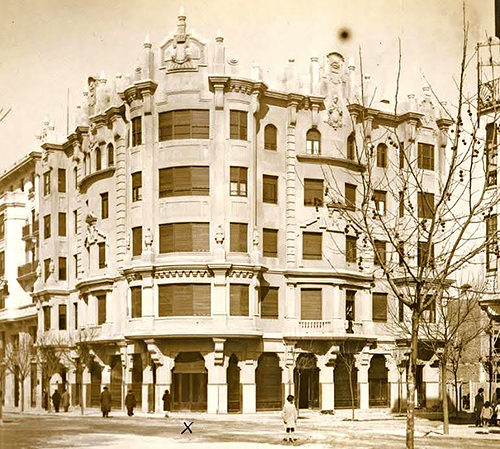
group At the end of the 19th century, the Art & Craft movement was born in England, a group of thinkers who defended artisanal production against industrial production and debated the impact of the industrial revolution on the design. Simultaneously, the avant-garde movements that emerged in France and the rest of Europe at the end of the 19th century and the beginning of the 20th century renewed the foundations of the bourgeois aesthetics of the time. With this background, at the end of the First World War, the School of Architecture Bauhaus arose in Germany, which revolutionized the decorative arts and constituted the instructions of the current modern design . The school proposed a new model of artistic training based on the combination of craftsmanship with industrial production and defended mass production as a method of obtaining cheaper and better quality objects, but with the need to have an important creative process and design that would allow the artist's intellectual development . This Philosophy, which is still in force today, revolutionized architecture and the decorative arts, gave rise to a profound renovation of design and led to the redefinition of some trades that had been little recognized until then, such as the interior designer or interior designer.
In the mid 20's, Julio Arrieta had the knowledge and the official document enough to exercise this new profession; probably a little known activity in Pamplona at the beginning of the century but that in the great European capitals was emerging strongly. The years of work in scenography, illustration, design or decoration had provided him with a solid base to start in this adventure. In addition, his experience in wood craftsmanship, backed by his cabinetmaking workshop and an important network of personal and commercial contacts, allowed him to exercise this new profession without problems. We know of his collaborations and possible friendship with the most important avant-garde architect of the time, Victor Eusa. We also know of his contacts with some of the best decoration and construction companies, such as Maumejean stained glass windows, the Madrid tapestry and pastry shops Los Pontones and Gil Bergasa furniture, or the Swiss company business for seamless compressed wood flooring, Eubeolith.
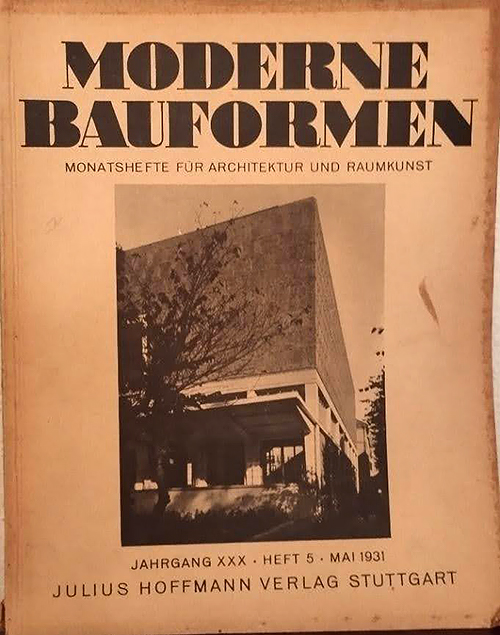
The documents preserved from his Library Services confirm that, in addition to his artistic experience and extensive contacts, Julio Arrieta possessed a solid training that qualified him to work as an interior designer. In his Library Services, kept by his family, we find a select collection of books, magazines and folders dedicated to architecture and decorative arts. In it are treasured classic works, but stand out for their modernity an interesting and select collection of magazines and portfolios specialized in the decoration of the moment. Thus we find two French publications: Boutiques, published in 1930 by the important Parisian architect and follower of L'Courbusier, Henry Delacroix, and Nouveaux interieurs français, published in Paris in 1933 by Charles Moreau. We also find the German magazine Moderne Bauformen Monatshefte für Architektur und Raumkunst, one of the most important in its field and a great disseminator of the ideas of the Bauhaus school. Finally, the English publication The furnishing trades organiser and hardware export journal, a monthly magazine on interior design. These publications, full of sketches and photographs, not only reflect Julio Arrieta's keen ability to identify and appreciate the most innovative trends of the time, but also served as sources of inspiration for his work.
Julio Arrieta's work as an interior designer can be found in some of the complete decoration works he carried out in Pamplona. Unfortunately, there is practically nothing left of these works today. A paradigmatic case is the decoration of the new Navascués pharmacy on Estafeta Street in 1925. The local press described Arrieta's designs in the new pharmacy as follows:
The artist has managed to harmonize in an unsurpassable way the seriousness of this class of establishments with the elegance and grace of the lines, without having a certain style in mind, but giving satisfaction to the modern taste. It is very pleasing to witness this progress in the decorative arts and the noble official document of cabinetmaking in our city.
Another important design of Julio Arrieta's business was the installation of the municipal box and Departments of the new Gayarre Theater, after winning the competition organized by the city council of Pamplona in 1932. The photographs and drawings preserved in the file Municipal de Pamplona show us a room decorated following the purest essence of the art deco style. Another integral decoration carried out by Arrieta was that of the cafeteria Iruña, adjacent to the Café Iruña, in 1934, of which we know from the press reports of the time that he collaborated with Gerardo Lizarraga. Nowadays it is called Hemingway's Corner. He also participated, in January 1927 with Víctor Eusa, in the decoration of the first parade of kings of Pamplona organized by the association de Prensa in Pamplona. In later years he continued to help in the designs of the parades, and so in 1935 it appears in the newspaper that he decorated a shepherd's hut.
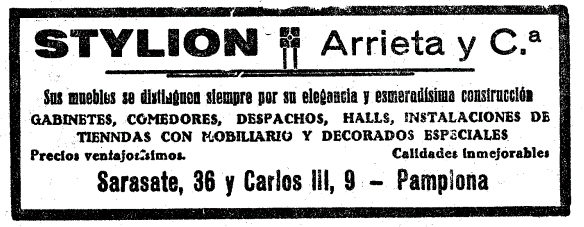
Between 1927 and 1931, a multitude of advertisements appeared in the local press for an establishment called Stylion-Arrieta y C.ª. It announced that "its furniture is always distinguished by its elegance and meticulous construction". The advertisement reported that the business had the exhibition at Paseo Sarasate No. 36 and the workshops and offices at Carlos III Street No. 9. These data suggest that around 1927 Julio Arrieta became a partner or bought Casa Stylion. This establishment had been founded in 1924 by the architect José Alzugaray and Arturo Picatoste, and soon became very popular. It was dedicated to the sale of decorative art objects for the home. In this exclusive and novel local Pamplona, and as José M.ª Muruzabal says, the first art exhibitions were held in Pamplona. Prestigious artists such as the Navarrese painters Julio Briñol (1925) and José Basiano (1926 and 1927), the Aragonese León Astruc (1931) or the Navarrese enameller Félix Artieda (1932) exhibited their works.
We have located an interesting drawing signed by Arrieta that was used as a full-page color advertisement for the Stylion house in Pamplona, whose date and edition we have not been able to determine. The advertisement is a testimony to Arrieta's talent as an advertising draughtsman and to the importance of the Stylion house in the commercial panorama of Pamplona as a symbol of modernity and good taste.
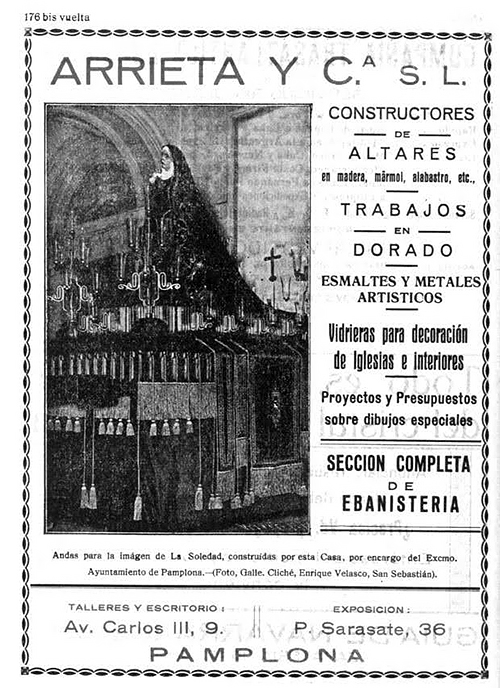
In the guide of Navarra of 1929-30, the business Arrieta y Cía. SL appears advertised in different sections. A large advertisement of the workshop appears on page 176 bis of the guide indicating that the business is dedicated to "constructions of altars in wood, marble, alabaster, etc. Works in gilding, enamels and artistic metals, stained glass for decoration of churches and interiors. Projects and estimates on special drawings".
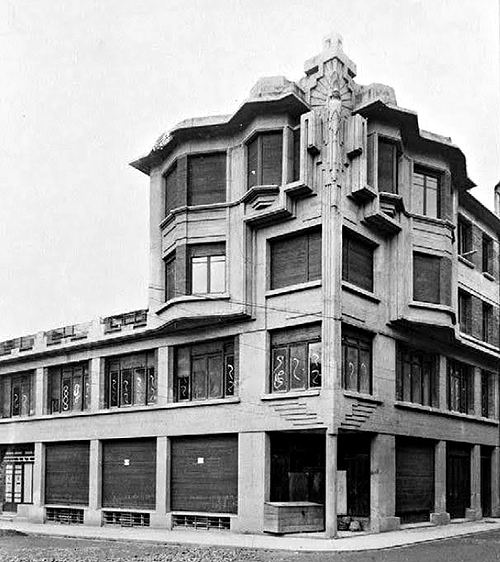
As Fernando Tabuenca relates, in 1929 the business Arrieta y Cía. SL commissioned Víctor Eusa to construct a building on the block formed by the streets García Castañón and Fernández Arenas No. 4. Julio Arrieta's business would dedicate the floor leave facing García Castañón street to exhibition, the one facing Fernández Arenas street to office and the office and workshop would be installed at the back. The second floor would be occupied entirely by offices and the second and third floors, smaller than the rest, by dwellings. We do not know the cause, but the original destination of the building changed. We can probably relate it to the arrival of the Second Republic. When the construction was finished, at the end of 1932, the first floor of the building was rented by the Mutua de Accidentes de Pamplona. Only a large sculpture of Athena, the goddess of the arts that presides over the building at the top of the main corner, reminds us of the building's original pretensions.
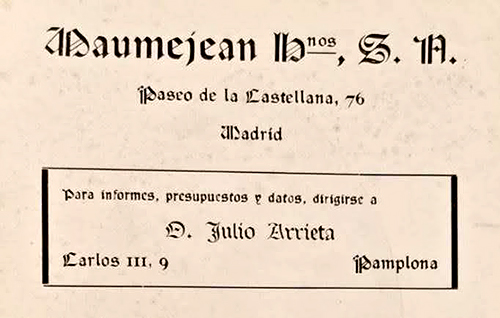
During the 1930s, Julio Arrieta played the position representative for the renowned stained glass house Maumejean. In 1933, in his capacity as representative of this prestigious business, he presented five stained glass windows at the exhibition of Decorative Arts organized by the Ateneo Navarro at the headquarters of the School of Arts and Crafts in Pamplona.
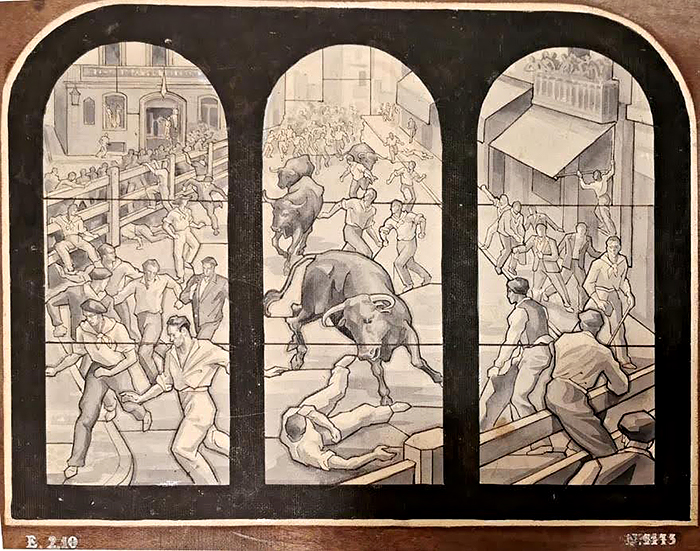
According to family testimony, in addition to the representation, Julio Arrieta also designed stained glass windows for the business. The family preserves a large number of sketches of stained glass of the signature Maumejean, among them we have called our attention one formed by three panels in black and white depicting a well-known scene of the running of the bulls in Pamplona in Mercaderes Street, which may well have been designed by Arrieta.
After 1935 we have no news of Arrieta in Pamplona. It seems that when the Civil War broke out and for economic reasons, Julio had to emigrate to Madrid, leaving his wife and daughter in Pamplona. According to family testimonies, Julio Arrieta worked in Madrid in the prestigious furniture and artistic bronzes house Herraiz y Cía., one of the best furniture companies in the country at that time.
In the 1950s, Julio Arrieta returned to Pamplona, settling with his daughter, son-in-law and grandchildren in the family home at place del Castillo no. 9. In this final stage of his life, the artist created an extensive pictorial work that remains in the hands of his family. Thanks to the partnership and generosity of his descendants, I have had the opportunity to catalogue more than 60 works composed mainly of watercolors, gouaches and ink drawings. These are works with a marked costumbrista character, showing rural or urban landscapes of Pamplona, still lifes or popular scenes of the time. Unfortunately, the limitations of this work prevent us from showing this interesting stage of his life.
On March 25, 1951, his wife died at the age of 60. Julio Arrieta died on January 3, 1966, at the age of 82; he left a daughter and five grandchildren. The press bade him farewell saying: "Yesterday he rested in the peace of the Lord in our city Mr. Julio Arrieta Zubiri, very well known and esteemed and whose death has been deeply felt by the extensive friendships that he knew how to conquer with his characteristic kindness. He was a prestigious industrialist of signature very accredited".
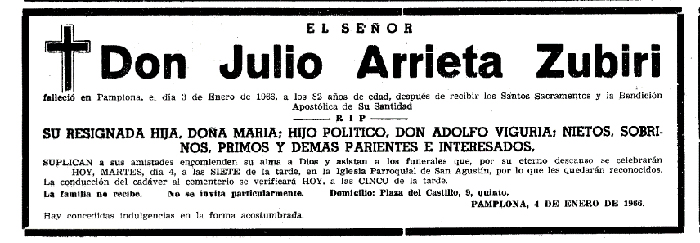
Cover of the report Reglamento del Vínculo ( 1916)
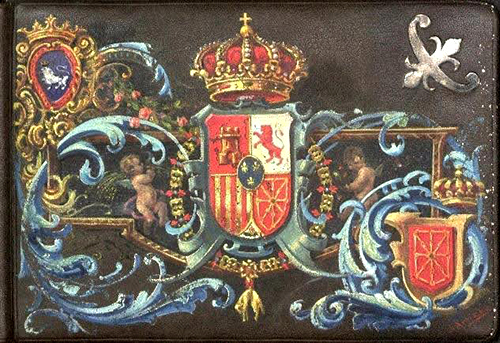

Photographs of the Library Services of the Royal Palace of Madrid.
In 1916, the City Council of Pamplona commissioned Julio Arrieta to decorate the cover of the publication report Reglamento del Vínculo to be sent to King Alfonso XIII. The municipality had published the regulations in August of the same year at the printing house of Huarte y Coronas in Pamplona. The purpose of the order was goal to send a luxuriously bound copy to King Alfonso XIII, who had requested to know the details of the functioning of the Vinculo, a municipal institution that guaranteed the supply of wheat to the population at stable prices throughout the year.
The book with the binding designed by Arrieta is currently in the Library Services of the Royal Palace of Madrid (call number IV-E-633). Arrieta's design is framed within a neo-baroque style. On the cover of the dark leather book, a royal coat of arms on leather and with a large crown occupies the center of the composition. The coat of arms is surrounded by the collar of the golden fleece and two angels. From the shield emerge large blue acanthus leaves that surround in the lower right part a crowned shield of Navarre. In the upper left part appears a coat of arms of Pamplona, also crowned, surrounded by golden leaves. In the upper right part there is a silver fleur-de-lis. A branch of pink roses joins the coat of arms of the city with the royal coat of arms. Finally, the presence of a fine elongated structure where the acanthus leaves are intertwined stands out in the background. The author's signature appears in red in the lower right corner of the front cover. On the back cover, also in dark leather, a large blue fleur-de-lis surrounded by a golden ring occupies the central area.
Pitillas Scroll (1917)
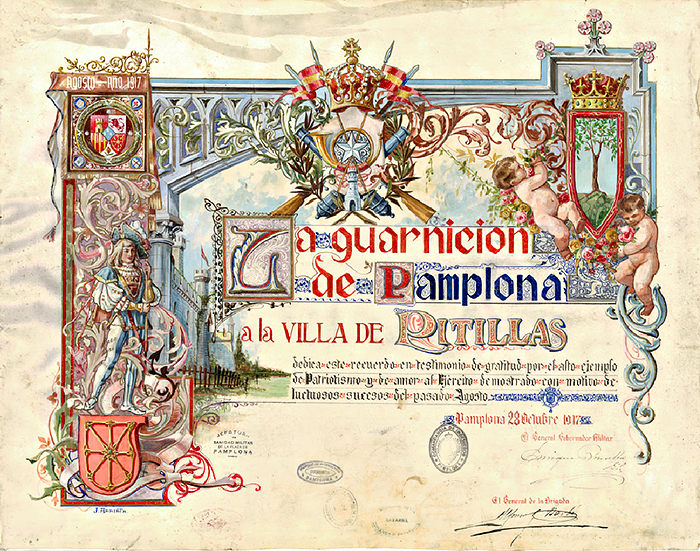
AGN Photograph (FIG_CARTELS,N.17)
In October 1917, the military garrison of Pamplona commissioned Julio Arrieta the design of a diploma to thank the solidarity shown by the town council of Pitillas with the army on the occasion of the disturbances caused by the general strike in August. The army had been in charge of maintaining public order in the town. The document reads: "The garrison of Pamplona dedicates this memento to the town of Pitillas as a testimony of gratitude for the high example of patriotism and love for the army shown during the mournful events of last August. Pamplona October 22nd 1917". The document is currently preserved in the file Real y General de Navarra (AGN) (reference letter ES/NA/AGN/13-2/FIG_CARTELES, N.17).
The parchment has a large neo-Gothic framework with a crowned shield in the upper central area. The shield is composed of a five-pointed star embedded in a bugle, surrounded by two olive branches. Behind the shield we find intertwined pairs of swords, spears, cannons and rifles. In the upper left corner is located the royal coat of arms inside a pennant supported by a herald. In the lower left corner we can see a coat of arms of Navarre and in the upper right corner, a coat of arms crowned with a tree supported by two angels surrounded by roses. The scene is completed by a medieval castle and a beautiful modernist calligraphy. In the lower half of the parchment there are up to twelve seals of the different army corps and institutes stationed in Pamplona.
Cover of the guide-Program of Pamplona (1918)
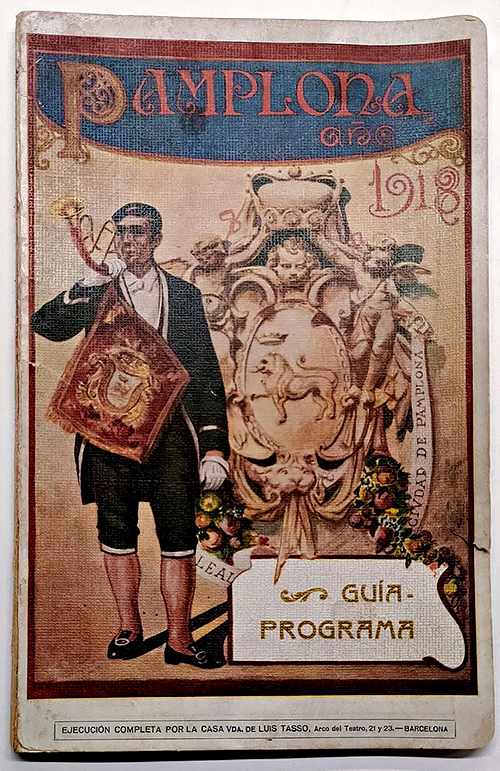
Photograph of file Municipal de Pamplona. José Ignacio Riezu Boj.
In 1918, Julio Arrieta was in charge of designing the cover of the guide-Programa de Pamplona published in color and embossed by Roldan y Goñi on the occasion of the San Fermín festivities of 1918.
In the center of the cover is sample a large oval coat of arms of Pamplona imitating a high relief in stone surrounded by two angels holding a crown. From the shield hang two floral garlands of great color and surrounds it a ribbon-lettering where it can be read "Loyal City of Pamplona". On the left, a clarinet player of the town hall plays the bugle from which hangs a large pennant with the coat of arms of the city. A copy of the guide is conserved in the file Municipal of Pamplona (call number: Folletos-227).
Drawing of a Roncalés (1920)

Drawing from Diario de Navarra, 18-7-1920, Supl p 21
On July 18, 1920, Diario de Navarra published an elaborate and extensive 32-page supplement on the occasion of the celebration, between July 18 and 25, of the II congress of programs of study Basques in Pamplona. Numerous journalists, writers and researchers participated writing about different Navarrese topics. A select group of cartoonists also collaborated with the supplement, including Julio Arrieta, Enrique Zubiri and Ricardo Tejedor. On pages 6 and 7 of the supplement, Arrieta drew six coats of arms of the respective merindades of Navarre, including the leave Navarra. In addition, on page 21 of the supplement we find a two-column drawing graduate "un roncales" signed by J. Arrieta. It is of a man with the costume of the Roncalesa gala: cloak, valona, breeches and headdress with a sastago hat. In his right hand he holds a long stick.
Cover of the guide of the Congressman of the II congress of programs of study Basques (1920)

Photograph by José Ignacio Riezu Boj
In 1920, Arrieta decorated the cover of the guide of the Congressman of the II congress of programs of study Basques. The meeting, held between July 18 and 25 in Pamplona, prepared a 100-page guide for the congressmen, edited by M. Mestres and written by Jesús Etayo and Francisco Javier de Arvizu Aguado. The cover presents in the center an oval coat of arms of Navarre bordered with the registration of the congress and framed in a vegetal framework ; in the upper part, an angelote, and in the lower part, a cartouche that says "PAMPLONA 1920" complete the cover.
Roncal Valley Coats of Arms (1921)
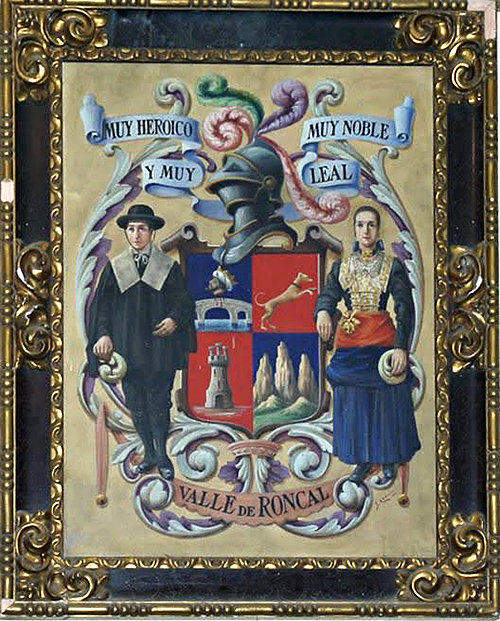
Photograph of the picture of the plenary hall of the town hall of Roncal. José Ignacio Riezu Boj
In 1921, Julio Arrieta made for the board of the Roncal Valley the composition and painting of seven paintings with the reproduction of the coat of arms of the Valley, one for each of the municipalities that make up the valley. Documents from the file of the board of the Roncal Valley inform us that the cost of the work was 2,380 pesetas, 1,750 for the canvases and 630 for the frames. The work included a smaller painting, but similar to the previous ones, for Mr. Valerio Labari. Mr. Labari seems to have been the one who managed the commission for the board del Valle. The painting features a large quartered shield with the currencies of the Roncal Valley flanked by a couple of Roncalians. A feathered helmet with four large feathers of different colors crowns the shield, from which flies a large cartouche that reads: "VERY HEROIC, VERY NOBLE AND VERY LOYAL". Below the shield, another cartouche completes the phrase saying: "VALLEY OF RONCAL". Large acanthus leaves surround the shield.
Cover of the score of the Official Hymn of the Centennial ( 1922)

Photograph published by Ricardo Fernández Gracia in Con Fondo y Forma.
One of the works carried out by Julio Arrieta for the III Centenary of the canonization of St. Francis Xavier was the design of the cover of the score of the official Hymn of the Centenary. The work, by Joaquín Larregla and Alberto Pelairea, was published by the Arilla House, for which they had the prestigious engraving and printing workshop of A. Boileau and Bernasconi of Barcelona. Julio Arrieta designed the color cover. According to Ricardo Fernández Gracia, "without a doubt, one of the richest musical works related to Navarra and Javier". This author explains:
On the cover we see one of the mace-bearers of the Diputación, seated with the ceremonial mace of the Kingdom and leaning with his left arm on the coat of arms of Javier, from which hangs a large rosary. The mace-bearer with long blond hair and a large beret with feather is dressed in yellow and wears a large coat of arms of Navarre on his chest. In the upper left margin, a matron with the score is ready to interpret and in the lower part is placed the degree scroll, the authors with their names and that of the Capuchin Father Policarpo de Iraizoz, author of the version of the lyrics in Basque. A narrow framework flooded with acanthus leaves surrounds the whole composition.
Cover of the Program of events or guide of pilgrims (1922)
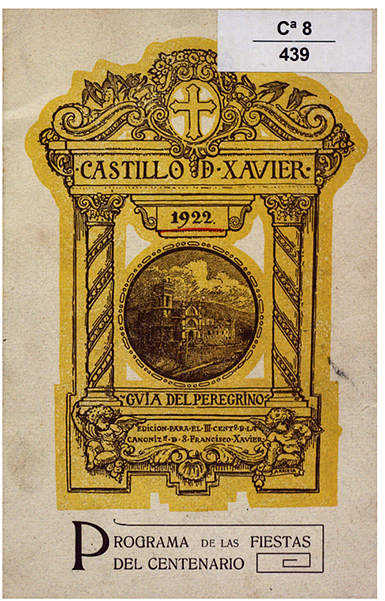
Photograph published by Ricardo Fernández Gracia in Con Fondo y Forma.
Another cover that Julio Arrieta made for the III Centenary of the canonization of St. Francis Xavier was that of the Program of events or guide of pilgrims. Professor Fernández Gracia describes it as follows:
It has a cover in two colors, the drawing itself in sepia on a yellow background. In it we find a great altarpiece with the bank with angels and a registration in which we read "EDITION FOR THE III CENTENARY OF THE CANONIZATION OF S. FRANCISCO XAVIER", a single body in whose interior it shines a circular medallion with a drawing of the castle and the date 1922, on him, and an attic with a cross between curved moldings, fruits and the registration CASTILLO DE XAVIER. The back cover shows a shield stamped by the royal crown with the arms of Navarre and in what would be the fourth quarter, those of Javier.
Pastries for the City Hall (1922)
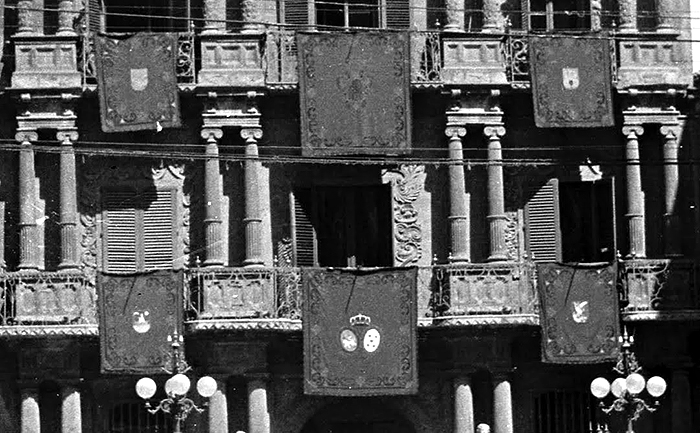
AGN Photograph (FOT_BELZUNCE_N_139)
In 1922, new reposteros were made for the balconies of the Pamplona City Hall following the designs of Julio Arrieta. They were delivered on July 5, 1922. The press explains that "Yesterday were delivered yesterday the pastry cases that have to be displayed during the days of the festivities on the balconies of the facade of the town hall. The bakers are very nice, very tasteful, and are subject to the design presented by the accredited industrialist Mr. Julio Arrieta".
In several photographs of the façade of the town hall between 1923 and 1930 one can see these reposteros hanging from the balconies. It seems that Arrieta made six reposteros: three for the second floor balconies and three for the second floor balconies. The reposteros for the two central balconies were larger than the rest. All the reposteros had a central shield surrounded by roundels, except for the repostero of the central balcony on the second floor. This had two oval shields with the obverse and reverse of the coat of arms of the city: a passing lion and the five wounds of Christ, respectively crowned with a royal crown. The central coffered ceiling of the upper balcony possibly bore the coat of arms of Spain, and the four remaining coffered ceilings bore the coats of arms of the four neighborhoods of the city: San Cernin, Navarrería, San Miguel and San Nicolás. We can deduce the color used by Arrieta for the pastry cases from the 1929 San Fermín festival poster signed by Basiano, which shows the façade of the town hall with Arrieta's creation. The six pastry cases were blue with maroon trimmings. The reposteros are preserved today in the warehouses of the Pamplona City Hall, but we have not been able to study them.
Pilgrim's medal (1922)
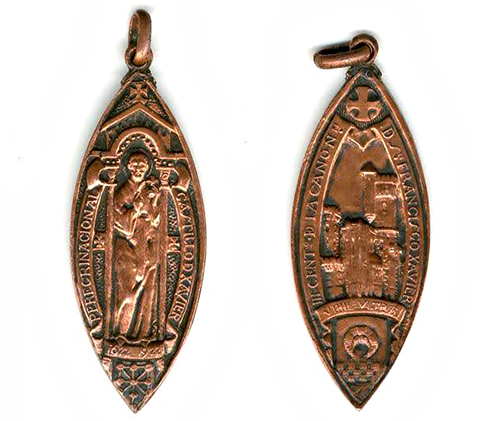
Photograph published by Ricardo Fernández Gracia in Con Fondo y Forma.
As we know from the press, the board organizer of the III Centenary of the canonization of St. Francis Xavier adopted among its first agreements to mint a medal for the pilgrims, commissioning the design to Julio Arrieta. The pilgrim's medal was almond-shaped and, as Professor Fernández Gracia tells us, "the minting was done according to the designs and their inscriptions, stating the commemorative dates and the reason for the minting -pilgrimage to the castle-".
Official centennial medal (1922)

Photograph published by Ricardo Fernández Gracia in Con Fondo y Forma.
The board organizer of the III Centenary of the canonization of St. Francis Xavier also commissioned the design of another medal to Julio Arrieta. As Ricardo Fernández Gracia explains, it is the official medal of the Centenary made by Ramón Arcaya (1895-1943) and measures 55 mm. The magazine La Avalancha describes it as follows:
Our countryman Ramón Arcaya has finished the model, according to the model of don Julio Arrieta for the official medal of the Centenary. This drawing has on the obverse the image of St. Francis with a converted and a miraculously cured, on the reverse the arms of Navarre. The registration of the medal will be in romance on the obverse and in Basque on the reverse. This medal has all the character of the medals of the time of the Canonization.
Francisco Bergamín Parchment (1923)
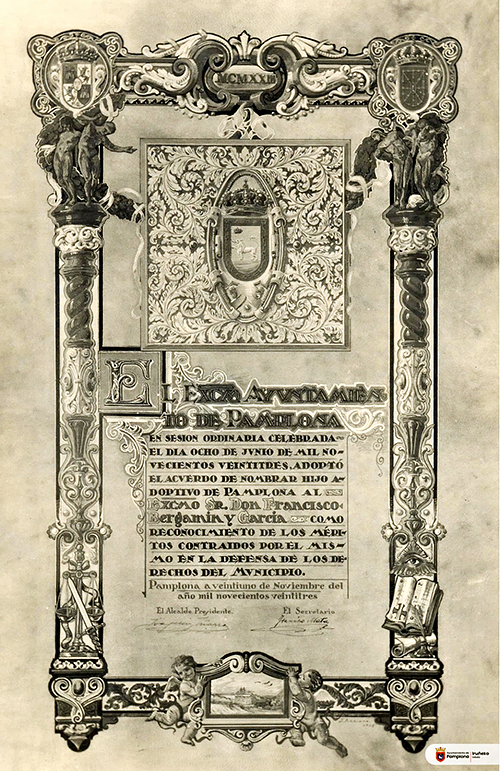
Photograph of file Municipal de Pamplona (AMP003074 p 2)
On June 8, 1923, the Pamplona City Council decided to name one of the streets of the Ensanche after him and to name Don Francisco Bergamín y García an adopted son. This politician from Malaga, who served as a minister in several cabinets of Alfonso XIII, performed the duties of Pamplona's lawyer in Madrid. As Minister of Instruction in 1914, he recognized by law the right of Navarre to appoint teachers. As a lawyer for the City Council of Pamplona, he defended the council, winning against the landowners of the Ensanche. As Minister of the Interior, in 1920 he signed the law project that granted Pamplona its urban expansion to realize the Ensanche after the demolition of the walls facing the south of the city. The city council's gratitude was made official with the sending of a parchment designed by Arrieta in which the city's agreement was recorded.
The file municipal of Pamplona preserves black and white photographs of the parchment (Fototeca AMP00303074 p2). It is a large vertical parchment with two large columns topped by two atlantes holding two crowned coats of arms. Those on the left hold the royal coat of arms and those on the right, the coat of arms of Navarre. The coats of arms are joined by a structure that in the center presents the issue 1923 in roman. From this structure hangs a large picture profusely decorated with vegetal motifs in the center of which is the crowned coat of arms of the city of Pamplona. The columns present at their base the symbols of the professions exercised by the honoree: the one on the left the symbols of lawyer (scales and sword) and the one on the right the symbols of legislator (trinitarian eye on code, pen and inkwell and scroll). The columns are joined at the bottom with a structure that presents in the center a window supported by two angels through which an image of the walls and towers of the cathedral of Pamplona can be seen. In the center of the parchment it can be read: "THE EXMO. CITY COUNCIL OF PAMPLONA IN ORDINARY SESSION CELEBRATED THE EIGHT OF JULY OF ONE THOUSAND NINE HUNDRED TWENTY THREE, ADOPTED THE agreement OF NAMING ADOPTIVE SON OF PAMPLONA TO THE EXMO. Mr. Francisco Bergamín y García AS A RECOGNITION FOR THE MERITS HIMSELF IN THE DEFENSE OF THE RIGHTS OF THE MUNICIPALITY. Pamplona, on the twenty-first day of November, nineteen hundred and twenty-three".
Diploma for regional livestock contests (1930s)
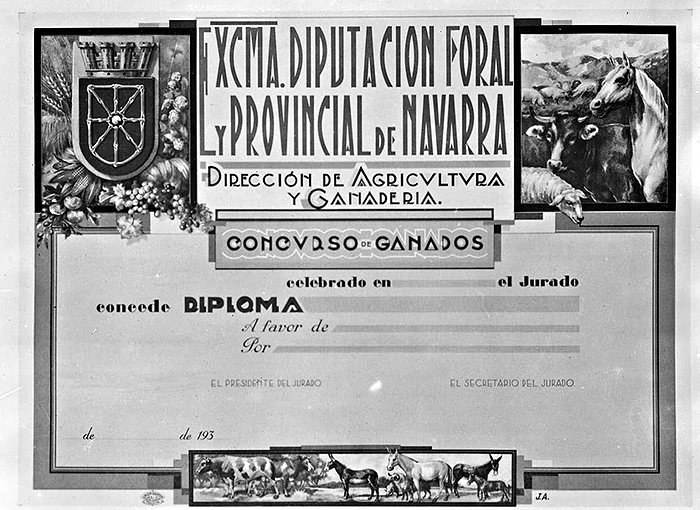
AGN photo (DFN_IMG4556)
Another work that we have found designed by Julio Arrieta and related to the illustrator's work is the diploma awarded to the winners of the regional livestock competitions organized by the Agriculture and Livestock Department of the Provincial Council.
The AGN preserves a photograph (ES/NA/AGN/F001/DFN_IMG4556) of the model of diploma signed by Julio Arrieta. The same file explains that "the diploma was elaborated during the years of government of the Second Spanish Republic, as the crowned tower of the coat of arms of Navarre shows, although it must have continued to be used after the outbreak of the Civil War".
In the upper part of the diploma, in a central box, there is the institutional accredited specialization of "EXCMA DIPUTACIÓN FORAL / Y PROVINCIAL DE NAVARRA / DIRECCIÓN DE AGRICULTURA / Y GANADERÍA / CONCURSO DE GANADOS", flanked by illustrations alluding to agriculture and livestock: on the left side, the coat of arms of Navarre with a turreted crown and surrounded by cereals and fruits; and on the right, several heads of livestock, such as a horse, a cow and a sheep. In the center of the diploma is the form to fill in with data about the contest and the winner. At the bottom, a narrow illustration presents several full-length domestic animals.
advertisement Stylion (1930s)
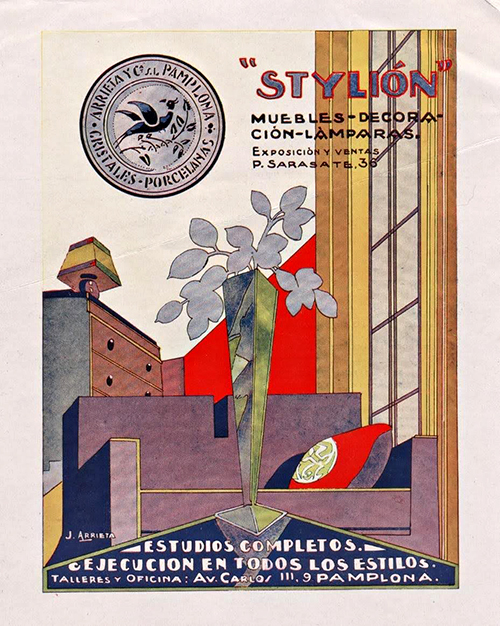
Photograph by file José Ignacio Riezu Boj
In a well known online auction platform we have found a full color drawing advertising the Stylion establishment in Pamplona signed by Julio Arrieta. Unfortunately we have not been able to date the advertisement or locate the publication, although we believe it may be from the early 30's. The advertisement in color and occupying the entire page of the magazine, follows the art deco style characteristic of the time. sample an elegant living room where you can see, in the foreground, a stylized and elongated vase in front of a two-seater sofa Further back on the left, a stretched chest of drawers holds a square lampshade. On the right, a very long window with the curtains pulled back illuminates the room. The great verticality of the composition and the use of color are the most outstanding features of advertisement. In the upper left part we see in black a stamp of a bird with the circular cartouche: "ARRIETA Y CIA PAMPLONA. CRISTALES PORCELANAS". In the upper right zone we read in big and between quotation marks the name of the establishment "STYLIÓN" and underneath "MUEBLES-DECORACIÓN-LÁMPARAS. exhibition AND SALE P. SARASATE 36". In the inferior zone of the drawing and next to the signature of the artist we find: "programs of study COMPLETOS. EXECUTION IN ALL STYLES. WORKSHOPS AND OFFICE: AV. CARLOS III 9 PAMPLONA". The advertisement is a testimony of Arrieta's talent as an advertising artist and of the importance of the Stylión house in the commercial panorama of Pamplona as a symbol of modernity and good taste.
Municipal box and Departments of the Gayarre Theater (1932)
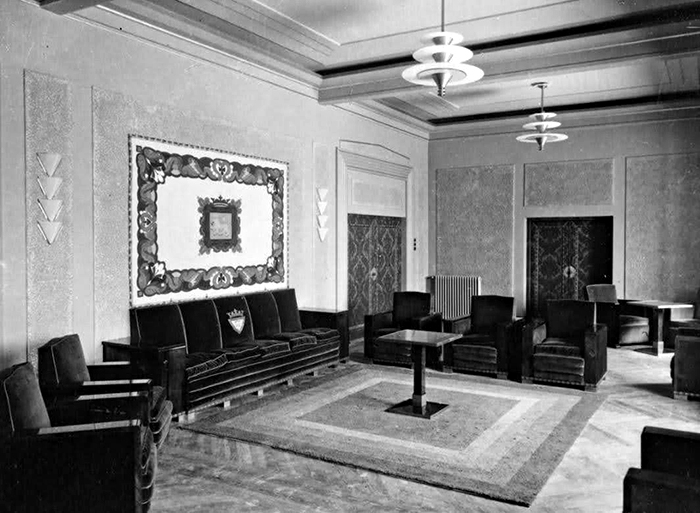
AGN Photograph (DFN_IMG4699)
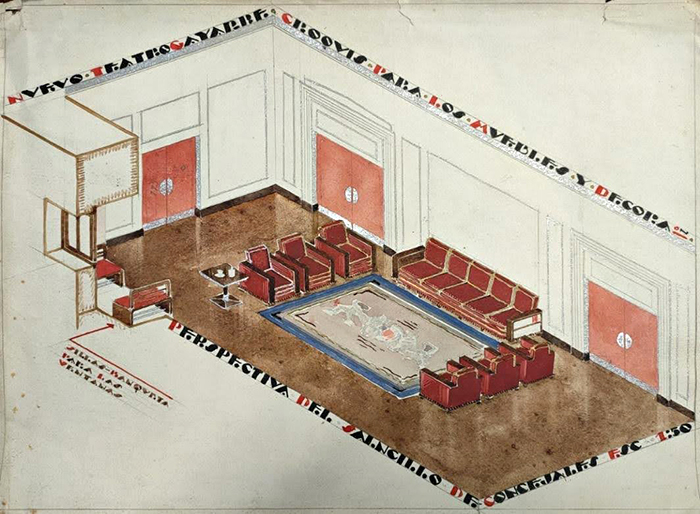
Photograph of file Municipal de Pamplona. José Ignacio Riezu Boj.
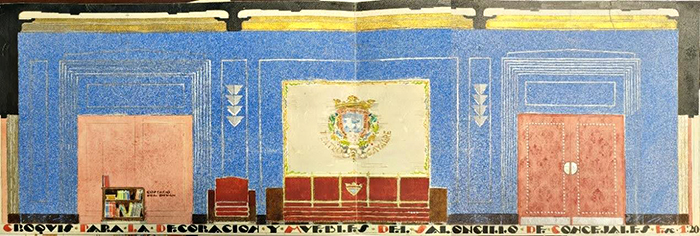
Photograph of file Municipal de Pamplona. José Ignacio Riezu Boj.
The business Arrieta y Compañía won the competition for the installation of the municipal box and Departments of the new Gayarre Theater in 1932. The file Municipal of Pamplona preserves the entire process of the competition and the awarding of the project to the architect Javier Yarnoz. Among the documents are five color drawings, four of them of the municipal hall and a fifth drawing of the municipal box. This is most likely the proposal of Yarnoz's decoration that Julio Arrieta scrupulously followed when he was awarded the contract. According to the invoice presented by Stylion, Arrieta y Cía., the project cost 22,450 pesetas:
For the complete decoration of a salon in the new Gayarre Theater in oil painting, relief paste splashed with silver and gold lines. Oil painting of a small salon in silver filleted grays. Oil painting of walls and ceilings of the toilets. Construction of furniture for the box, salon and lounge and toilet utensils as listed.
The AGN and the photo library of the file Municipal de Pamplona also has photographs of the main hall which, together with the drawings mentioned above, allow us to see the municipal hall in detail. It is a large room with a small square table in the center that rests on a straight striped carpet. Surrounding the table are six sofas, of a single place, with sober and elegant straight lines, and a large five-seater sofa with the coat of arms of the city on the central back. The sofas according to invoice "are made of walnut bookcases, miraguano cushions, old gold cords, gold fretwork on wood, chromed metal feet and red velvet". Above the five-seater sofa, hanging on the wall, there is a large coffee table with the insignia of the city, surrounded by a garland of scrolls. Other small tables surrounded by the same sofas complete the room. Between the doors, on the blue walls, four large decorative panels frame light fixtures composed of four triangular shapes, opaque glass and chrome. Four large doors, upholstered in red damask, with metal studs and highlighted with large moldings, give access to the conference room. From the ceiling, which has enormous rectilinear moldings, hang two precious chandeliers with a striking design formed by three successively larger hanging circles. The whole ensemble strictly follows the dictates of the art deco style, which was at its height in those years.
Engraved cover (1933)
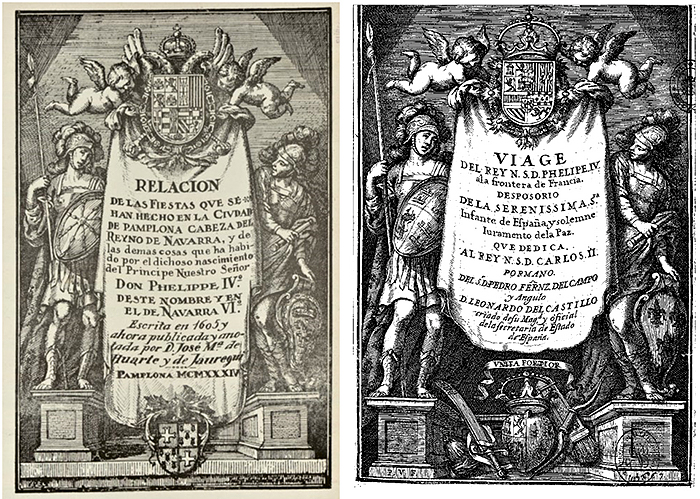
Left: photograph from Cultura Navarra nº 6 p 223. Right: photograph provided by Ricardo Fernández Gracia.
In 1933, the magazine Cultura Navarra, organ of the committee and Executive Council of Culture of Navarra, Ateneo Navarro, in its issue December 6, in the pages 223 and following, publishes a article of its director, the historian and archivist Jose Maria de Huarte, graduate: "RELACIÓN DE LAS FIESTAS QUE SE HAN HECHO EN LA CIUDAD DE PAMPLONA CABEZA DEL REYNO DE NAVARRA, y de las demás cosas que ha habido por el dichoso nascimiento del Príncipe Nuestro Señor Don Phelipe IV deste nombre y en el de Navarra VI Escrita en 1605 y ahora publicada y anotada por D José M.ª de Huarte y de Jauregui Pamplona MCMXXXIV". The article begins with an engraving signed by Julio Arrieta. The artist used to make this drawing, as Professor Ricardo Fernández Gracia has pointed out, the cover that the engraver Pedro de Villafranca Malagón designed for the book written by D. Leonardo del Castillo in 1667 describing the work of D. Leonardo del Castillo. Leonardo del Castillo in 1667 describing the signature of the Peace of the Pyrenees, in the Island of the Pheasants (Irún), on November 17, 1659, graduate "Viage del Rey Nuestro Señor Don Felipe Quarto el Grande, a la frontera de Francia: funciones reales, del desposorio, y entregas de la Serenissima Señora Infante de España Doña María Teresa de Austria...".
At the top of the engraving we can see a crowned shield of the Hispanic monarchy with an imperial double-headed eagle, supported by two angels. From the shield hangs a large cloth where the long degree scroll of article is inscribed. Flanking the sides of the curtain, two soldiers with the coat of arms of Navarre and Pamplona close the scene.
-file Pamplona Municipal (AMP)
-file of the board of the Roncal Valley, box 4, folder 30.
-Library Services of the Royal Palace of Madrid
-file of the Museum of Decorative Arts of Madrid
- Sancho el Sabio Foundation
-file staff from the family of Julio Arrieta
- Navarra Newspaper
- The Avalanche
- The Spanish Post
- Echo of Navarra
- Navarre Village
- The Voice of Navarra
- The discussion
- Culture Navarra
- Photo Library of file Royal and General of Navarre
- AMP Photo Library
- database online FamilySearch
DE ORBE SIVATTE, A., Arquitectura y Urbanismo en Pamplona a finales del siglo XIX y principios del XX, Pamplona, Gobierno de Navarra, 1985.
FERNÁNDEZ GRACIA, R., "Julio Arrieta al servicio de la imagen del III Centenario de la canonización de san Francisco Javier en Navarra", Con Fondo y Forma.
guide of Navarre of 1924-25. Pamplona: Angel Sáiz-Calderón, 1924.
guide of Navarre of 1929-30. Pamplona: Angel Sáiz-Calderón, 1929.
MURUZABAL DEL SOLAR, J. M.ª, "La conference room de exposiciones de García Castañón de Pamplona: un viaje del arte local al arte global", Príncipe de Viana, n.º 262 (2015), pp. 985-1000.
TABUENCA GONZÁLEZ, F., "Arquitectura de Víctor Eusa", thesis doctoral, Universidad Politécnica de Madrid, 2016.
